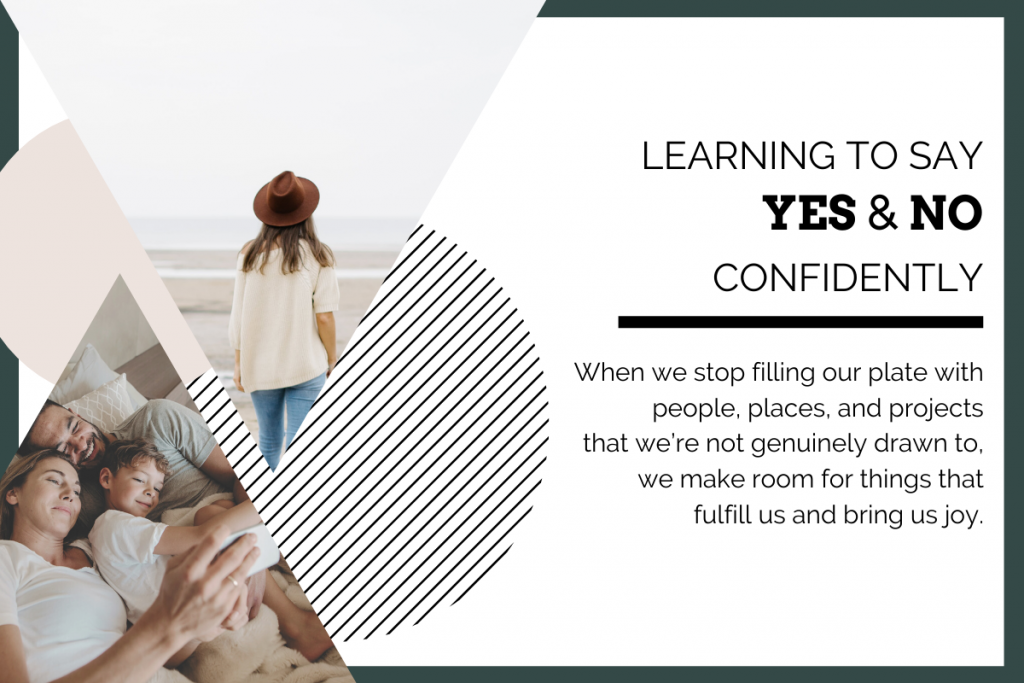Setting Healthy Boundaries: YES & NO
Healthy boundaries are essential for successful relationships, romantic and otherwise, and a balanced, joyful life. Without boundaries, it gets hard to determine our limits and often we find ourselves overwhelmed and stressed out—not to mention feeling guilty about our choices.
However, it doesn’t have to be that way. With a few tools in your toolbox and a bit of practice, you’ll be able to set healthy boundaries that align with your values and allow you to live a life you’re proud of and excited about. Let’s dive in.
Setting Healthy Boundaries: Learning to Say “Yes” and “No” Confidently

Know and Understand Your Limits
You can’t set boundaries without determining your limits. Take a few moments to identify your physical, emotional, mental, and spiritual limits—then write them down. This will give you a good framework for moving forward and help guide you as you set boundaries.
Tune In to Your Inner Voice
Most decisions ultimately come down to saying “yes” or “no.” To truly set healthy boundaries, you need to learn how to confidently say both. The best way to do this is by tuning in to your inner voice and truly listening to what it tells you. Think of it like a compass with two directions—yes and no. When you’re faced with a decision or asked to commit to something, take a moment to check your compass: which direction is it pointing?
If the situation makes you feel uneasy, stressed out, resentful, or misaligned—don’t ignore those feelings. Ask yourself what about the situation is causing you these thoughts and make a decision moving forward that helps ease your negative emotions. If the situation makes you feel excited, happy, safe, and aligned—follow that feeling.
Sometimes tuning in can be difficult, especially in our loud busy world. If you find yourself struggling to hear your intuition, there are a few steps you can take:
- Separate yourself from the situation and find a quiet place where you can think about your options without outside pressure.
- Take some time to meditate each day—this will help you quiet the outside world and practice listening to your intuition. If you are a believer, spend time each day in prayer and practice listening to the voice of the Holy Spirit.
- Practice mindfulness. The goal of mindfulness is to create a safe space you can remain alert and relaxed by deliberately paying attention to thoughts and feelings without judgement.
- Take time each day to journal. Here is a guide full of journaling tips and techniques as well as prompts to get you started.
Learn to Let Go
How other people feel about your decisions isn’t your responsibility. When you start setting healthy, firm boundaries, it’s likely some people won’t be happy about it. That’s okay! The people you want to surround yourself with will respect your boundaries—even if they’re not excited about them. Your job is to learn to let go of accepting responsibility for other people’s reactions. When someone reacts negatively to one of your boundaries, stay firm, don’t apologize, and breathe through it. Allow them to accept responsibility while you do the same.
Learn to Say “Yes”
Your boundary compass has two directions: yes and no. Both are equally important to follow at different times. Saying “yes” can be difficult because it often means stepping out of your comfort zone and trying something new. However, that can be a beautiful thing and lead to loads of personal growth. Knowing the difference between saying “yes” because it could open lots of doors and saying “yes” because you feel pressured takes time. Here are some tips:
- Say “yes” if you’re feeling excited, safe, relaxed, aligned, and maybe even a little scared.
- Don’t say “yes” if you feel like saying “no” would upset someone else—even though you really want to.
- If you’re feeling pressured or the other person is using guilt as a tool, that’s usually a sign to say “no.”
Prepare to Say “No”
Telling someone “no” is a lot harder than diving into “yes,” because it often feels like we’re letting someone down. And if you’re a people-pleaser or workaholic, that feeling can be almost paralyzing. However, when you don’t listen to your intuition and choose to ignore your compass, you’re setting yourself up for feelings of regret and resentment. One of the easiest ways to get comfortable saying “no” is by preparing for it. Having a few options in your toolbox makes that easy. Next time, try one of these:
- Vague but effective: “Thank you for asking, but that isn’t going to work for me.”
- It’s not personal: “Thank you for asking, but I’m not taking on any extra volunteer hours until my son’s baseball is over.”
- Ask me later: “I want to do that, but I’m not available until December. Will you ask me again then?”
Side note: Never feel like you need to apologize for saying “no” and sticking to your boundaries. If someone falls outside your limits (which we set above) you have every right to state that.
Saying “No” Really Means Saying “Yes”
When you say “no” to things that don’t fit your life or that you don’t have the capacity for, you’re actually opening up space to say “yes” to things you do. Think of it this way: If you say “no” to attending your friend’s dinner party, you could be saying “yes” to spending the evening playing board games with your kid. Sure, your friend might be bummed—but your kid will be thrilled. When we stop filling our plate with people, places, and projects that we’re not genuinely drawn to or that are not in keeping with our values, we make room for things that fulfill us and bring us joy.
The NOT To-Do List
If you are looking at your calendar and overwhelmed but still unsure what you need to say “no” to, try using this NOT to do worksheet to figure out what is truly a priority.
Don’t Forget Self-Care
You’ve probably heard the saying, “You can’t pour from an empty cup.” And it’s true. You can’t give others the best version of you if you’re not taking care of your needs first. This means taking time each day to check in with yourself and see how you’re feeling—what do you need? What’s missing? Are you stressed? Tired? In need of a break? Give yourself permission to meet those needs in whatever way feels right to you. Everyone’s self-care looks a little different, but yours could include:
- Journaling
- Meditation or Prayer
- Exercise
- Reading a good book or your Bible
- Getting your nails done
- Going for a massage
- Taking a long walk
- Playing with your dog
- Dance party with your kids
When you start setting firm, healthy boundaries, life gets a whole lot better and your relationships do too. Keep practicing, keep tuning in, and keep following your compass. If you are needing help with setting or keeping your boundaries, contact us. You are not alone!

